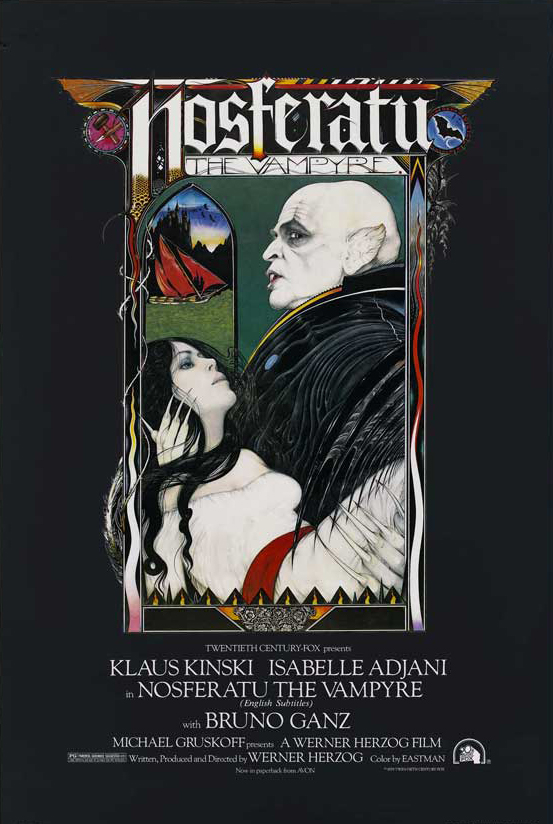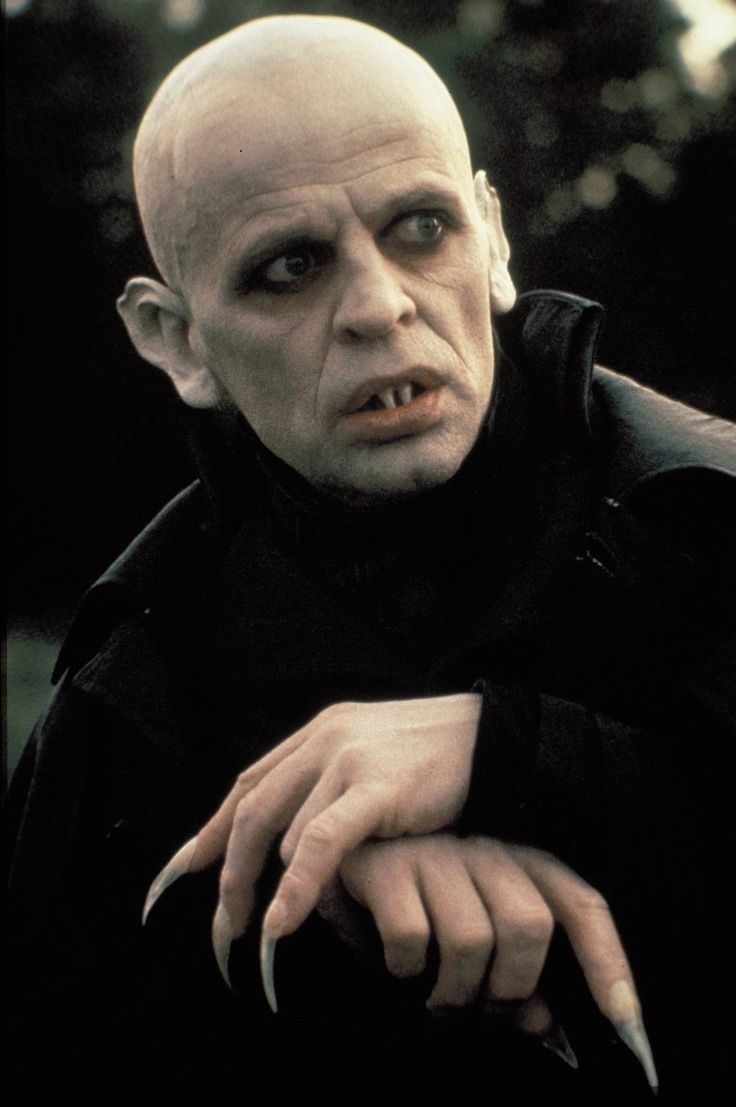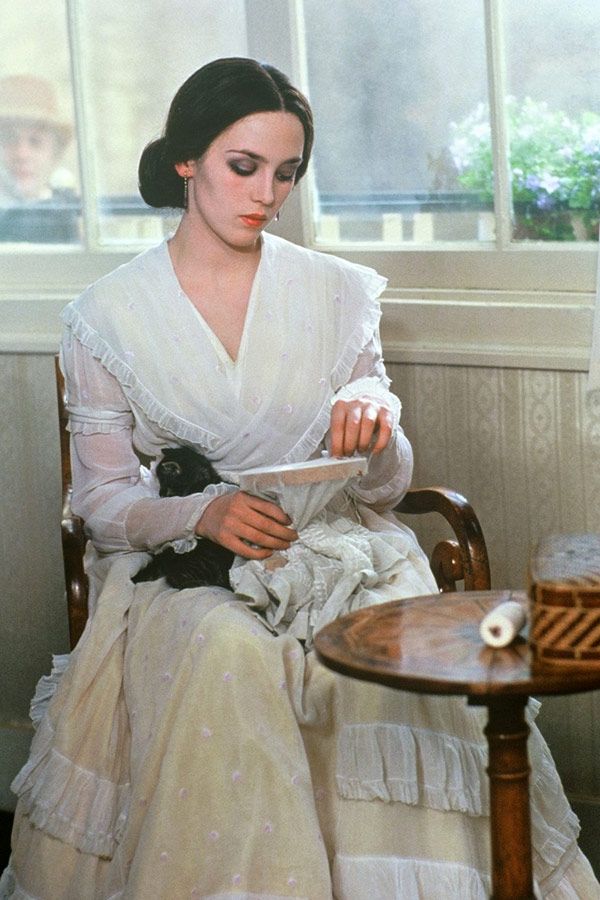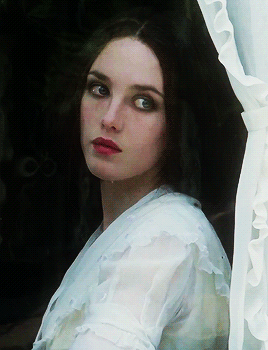

I wanted to like this movie, I really did. I went into it thinking about how it would compare to the beautiful striking gothic visuals of the original, but hopeful because it was directed by the great Werner Herzog! I hadn't seen any Herzog movies before seeing this one, but I knew that people generally really liked and respected him and his work, so I was hopeful. And here's the thing, it is good, its definitely good. I can tell that it was made incredibly competently, it is full to the brim with beautiful shots, it has an astounding performance by Isabelle Adjani as Lucy (both this film and the Hammer Dracula movie switch the names of Lucy and Mina from the books for some reason), and honestly it has a considerably stronger ending than the original. But despite all of those amazing parts, the whole ends up feeling less... distinct, compared to the original Nosferatu. Maybe its a preference for the stark black and white versus the more muted colors of Herzog's version, maybe its just that I prefer Max Schreck's Count Orlok to Klaus Kinski's Count Dracula. Actually that last part definitely does play a major role in how I feel. On the whole, despite a strong opening and a strong closing, the middle of the film felt like a drag; I can tell its a great film, but I just didn't like it as much as the original.
I really do think, though, that probably the root of most of my problems with it is just in the simple transition from a black and white silent film to a color film with dialogue. Despite so many of the shots being very striking, none of them felt as dark, brooding, and Terrible with a capital T as any given piece of the Murnau version. With regards to dialogue, there is a simple economy of language forced on the filmmaker by lack of dialogue. I found myself thinking about that with the inn scene, where in the Murnau version there is a very quick reaction to a single statement on the part of Harker, while in the Herzog version it gets bogged down in a lengthy conversation with the innkeeper and others. I appreciate the more authentic costuming and performances there of rural Transylvanians in the Herzog version, but a simple line followed by a visually communicated reaction was just stronger than getting bogged down in conversation. The inn scene went on for so much longer than in the Murnau version!

And then there is the titular Nosferatu himself. Like I said above, I just prefer Schreck over Kinski. I have no doubt Klaus Kinski is a great actor, I haven't seen him in much other stuff but I fully intend on doing so, I just think his performance of the Count in Herzog's Nosferatu loses all of the distinct character of the original. He comes out more simpering, sad, nervous, and sickly; it is perhaps a more nuanced portrayal of the character, but I don't know, for me the starkness of Schreck's performance shone through. A friend of mine who prefers this version to the Murnau original told me that Herzog and Kinski are aiming for a more nuanced portrayal of a more human character here, someone who is much more pitiful and sad and monstrous, and I can definitely appreciate that, normally I actually love pitifulness, but in this case it just didn't work for me.
Not all is so bad though! I vastly prefer this version's female characters, namely Lucy (Mina) Westenra. In the Murnau version she is functionally not even a character, given basically no personality and just used to lure out the Count at the end. Here she still lures the Count to his demise, but rather than it being Van Helsing's idea, it is hers. She generally has more agency, and in truth I think it would be more accurate to say that she is the protagonist of the film, rather than Harker. Also I just think Isabelle Adjani is absolutely beautiful, and she did a stellar job in her performance in this film. Where I feel like Kinski's Count does little for me compared to the original, Adjani's Lucy is a homerun, honestly this movie is kinda worth it just for her. I also think the ending of the film is just objectively better compared to the original. I won't spoil too much here, but suffice to say it does much more interesting things with Lucy, Harker, the Count, and vampirism than Murnau's. The question then is, does one of the best endings to a vampire movie make up for the slow, plodding pace and poor economy of storytelling of the rest of the movie? The film also deals more directly with the issues of disease and plague with some great scenes centering on that, something which I also prefer to the original's vague gesturing.
So then, the question is: a movie with an incredibly distinct visual style vs. one that has beautiful shots but otherwise feels little different from the movies of its era? A film with a gothic monster masterfully performed by Max Shreck, or a pitiful sickly man performed by Klaus Kinski? One which subordinates characters to its horror narrative, or one that has stronger characters and a stronger ending? At this point, it's more a question of preference. While I prefer the characters here in the Herzog version, the aesthetic sensibilities of the original and its simple iconicness outweigh that, for me at least.
I give Werner Herzog's Nosferatu the Vampyre...

3 Bats out of 5!
EDIT (May 22nd, 2025)
Since Vampire Weekend (of no relation to the band of the same name) way back in February 2022 (jesus has it really been that long), I have now seen Werner Herzog's Nosferatu the Vampyre a second time, and the second watch completely changed my opinion of it! This was in the autumn of 2023, as part of a series of group watch parties of Herzog's films hosted by a good friend of mine, and I definitely think that engaging with a section of the rest of Herzog's filmography increased by appreciation for his Nosferatu. In light of Aguirre, the Wrath of God, or Fitzcarraldo, or Heart of Glass, so much of the melancholia, pitiableness, and themes of disease and isolation just... sort of made more sense. Count Dracula is a very different role for Kinski compared with Aguirre or Fitzcarraldo, with how quietly monstrous it is, as opposed to the usual overt bombastic anger and energy he brings to his other performances (which seems to just be how he actually is, so...). I also think that the second watch really cemented what I said above about Adjani's character, especially the empowering moment of her decisive choice to sacrifice herself in the end of the film. Also also, Herzog's version is so much more vibrant and interesting visually on the second watch! Parts of the film, like during the montages of travel to Transylvania (which I kinda ragged on in the above review) remind me almost of like, cool prog rock wilderness vistas with mountains starkly cut against the sky. I hadn't seen it at the time of my second watch (because it wasn't out yet, obviously), but having now also seen Robert Eggers' Nosferatu (2024), I can say I really do appreciate the color choices and shot framing in Herzog's version. Not to say I think Eggers' is less artistic or anything, it's just interesting going from a black and white version (the original) to one with muted but still present colors (Herzog's) to one that in some scenes almost returns to monochrome color palettes (Eggers'). I'll have to write up thoughts about Eggers' Nosferatu some time, it deserves a page all its own, especially with how much I love the attention to historical detail and the very fittingly early 19th century themes. Honestly, every Nosferatu movie is good!!!
I'm going to keep the above original review up, just to register my change in opinion on this movie and for the sake of archiving, but the OFFICIAL score of Werner Herzog's Nosferatu the Vampyre is...

4.5 Bats out of 5!


She's just so pretty...
Click here to return to Vampire Weekend!
Click here to return to the homepage!